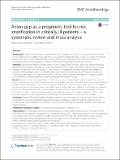Files in this item
Anion gap as a prognostic tool for risk stratification in critically ill patients – a systematic review and meta-analysis
Item metadata
| dc.contributor.author | Glasmacher, Stella Andrea | |
| dc.contributor.author | Stones, William | |
| dc.date.accessioned | 2016-08-31T14:30:10Z | |
| dc.date.available | 2016-08-31T14:30:10Z | |
| dc.date.issued | 2016-08-30 | |
| dc.identifier | 244033966 | |
| dc.identifier | e1ed5a47-c46d-434f-9805-ca82e5c3c4ca | |
| dc.identifier | 84984612095 | |
| dc.identifier | 000382199100001 | |
| dc.identifier.citation | Glasmacher , S A & Stones , W 2016 , ' Anion gap as a prognostic tool for risk stratification in critically ill patients – a systematic review and meta-analysis ' , BMC Anesthesiology , vol. 16 , 68 . https://doi.org/10.1186/s12871-016-0241-y | en |
| dc.identifier.issn | 1471-2253 | |
| dc.identifier.uri | https://hdl.handle.net/10023/9405 | |
| dc.description.abstract | Background Lactate concentration is a robust predictor of mortality but in many low resource settings facilities for its analysis are not available. Anion gap (AG), calculated from clinical chemistry results, is a marker of metabolic acidosis and may be more easily obtained in such settings. In this systematic review and meta-analysis we investigated whether the AG predicts mortality in adult patients admitted to critical care settings. Methods We searched Medline, Embase, Web of Science, Scopus, The Cochrane Library and regional electronic databases from inception until May 2016. Studies conducted in any clinical setting that related AG to in-hospital mortality, in-intensive care unit mortality, 31-day mortality or comparable outcome measures were eligible for inclusion. Methodological quality of included studies was assessed using the Quality in Prognostic Studies tool. Descriptive meta-analysis was performed and the I2 test was used to quantify heterogeneity. Subgroup analysis was undertaken to identify potential sources of heterogeneity between studies. Results Nineteen studies reporting findings in 12,497 patients were included. Overall, quality of studies was poor and most studies were rated as being at moderate or high risk of attrition bias and confounding. There was substantial diversity between studies with regards to clinical setting, age and mortality rates of patient cohorts. High statistical heterogeneity was found in the meta-analyses of area under the ROC curve (I2=99%) and mean difference (I2=97%) for the observed AG. Three studies reported good discriminatory power of the AG to predict mortality and were responsible for a large proportion of statistical heterogeneity. The remaining 16 studies reported poor to moderate ability of the AG to predict mortality. Subgroup analysis suggested that intravenous fluids affect the ability of the AG to predict mortality. Conclusion Based on the limited quality of available evidence, a single AG measurement cannot be recommended for risk stratification in critically ill patients. The probable influence of intravenous fluids on AG levels renders the AG an impractical tool in clinical practice. Future research should focus on increasing the availability of lactate monitoring in low resource settings. | |
| dc.format.extent | 13 | |
| dc.format.extent | 1198509 | |
| dc.language.iso | eng | |
| dc.relation.ispartof | BMC Anesthesiology | en |
| dc.subject | R Medicine | en |
| dc.subject | T-DAS | en |
| dc.subject.lcc | R | en |
| dc.title | Anion gap as a prognostic tool for risk stratification in critically ill patients – a systematic review and meta-analysis | en |
| dc.type | Journal article | en |
| dc.contributor.institution | University of St Andrews. School of Medicine | en |
| dc.contributor.institution | University of St Andrews. Global Health Implementation Group | en |
| dc.identifier.doi | 10.1186/s12871-016-0241-y | |
| dc.description.status | Peer reviewed | en |
This item appears in the following Collection(s)
Items in the St Andrews Research Repository are protected by copyright, with all rights reserved, unless otherwise indicated.

